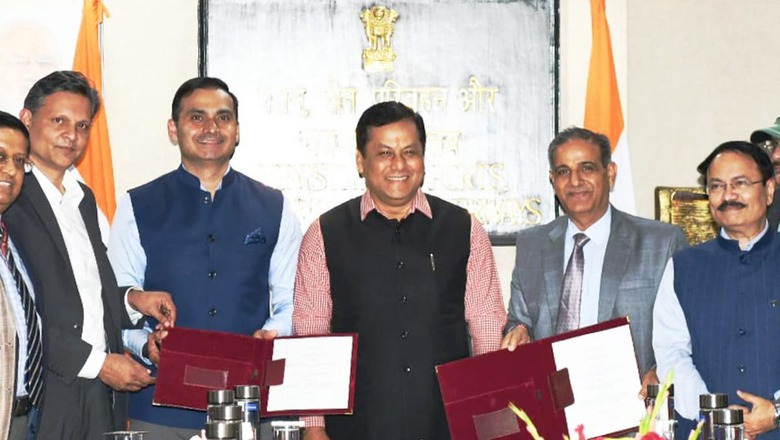
views
Ignored for decades, India’s rivers and canals are today bustling with activity. India is laying the ground for a drastic upscaling of inland waterways – the kind that can power the country’s goal of becoming a developed nation by 2047. After all, there is hardly any developed nation in the world that does not have a robust inland waterways system in place. In a big boost to cargo movement on Indian waterways, a memorandum of understanding (MoU) has been signed between Inland Waterways Authority of India (IWAI) and Amazon Seller Services Private Limited (Amazon). This will provide a boost to transportation of customer shipments and products via inland waterways using National Waterway 1 on the Ganga.
The MoU represents the changing dynamics of India’s inland waterways. With a major focus on boosting waterway infrastructure across the country, more such agreements to boost commercial shipments can be expected. There are already early indications that the Narendra Modi government’s focus on inland waterways is bearing fruits. Cargo movement on national waterways surged 16% in 2022-23. In 2014, there were only five waterways in the country, a number that in the past nine years has gone up to 111. This came after 106 waterways were declared national waterways under the National Waterways Act.
National Waterway 1, which runs from Prayagraj in Uttar Pradesh to Haldia in West Bengal via Patna and Bhagalpur in Bihar across the Ganga, is the longest waterway in India. Needless to say, it has a lot of potential to transform the entire Gangetic belt into a logistical powerhouse and a hub of cargo movement. This is why the Inland Waterways Authority of India (IWAI) is actively implementing the ambitious Jal Marg Vikas Project (JMVP) on this waterway. At a cost of Rs 4,633.81 crore, JMVP includes the establishment of multimodal terminals at strategic locations, namely Varanasi, Sahibganj, and Haldia, along with the introduction of an intermodal terminal at Kalughat.
Uttar Pradesh is particularly rich when it comes to inland waterways, housing 11 national waterways. Earlier in November, the Uttar Pradesh Interstate Waterways Bill-2023 was approved by the state cabinet. The draft law will enable the creation of a dedicated body that will regulate and monitor tourism and transport through the state’s rivers. The body, according to Chief Minister Yogi Adityanath, will promote water sports, increase tourism facilities and help in developing Uttar Pradesh as an export hub, apart from also giving water transport a major boost.
Setting the Ball Rolling on Maritime Connectivity with ‘Blue Economy’ Goal in Mind
In 2015, the Modi government had launched the Sagarmala initiative to enhance the performance of the country’s logistics sector with a special focus on inland waterways and infrastructure development along India’s vast coastline. As part of this initiative, the government has taken up 113 projects worth Rs 7,030 crore related to RoRo/RoPax and Inland Water Transport. Out of these, 15 projects worth Rs 1,100 crore have been completed and 32 projects worth Rs 3,900 crore are under implementation.
In October, during the Global Maritime India Summit, PM Modi had launched the Amrit Kaal Vision 2047. As per this vision document, India should increase its inland water transport volume to 500 MMT by 2047. At present, the inland water transport volume stands at 126 MMT. By 2030, the government plans to take this figure to well over 300 MMT. The Amrit Kaal Vision 2047 document also outlines the need to increase the number of operational waterways to 23 by 2030, and to take the number to more than 50 by 2047.
To achieve these goals, India is eyeing an investment of Rs 35,000 crore by 2047 to create a network of waterways in the country. The Northeast is especially in focus. Union Minister Sarbananda Sonowal, who himself hails from Assam and has previously been its chief minister, said on Tuesday that more than Rs 1,100 crore has been granted for the development of 25 inland waterways projects in the Northeast region. These projects have been accorded top priority and dubbed as ‘critical projects’ which need to be completed by January 2024.
In January this year, PM Modi had flagged off the MV Ganga Vilas luxury cruise on the world’s longest river voyage from Varanasi to Dibrugarh. The Brahmaputra, as a matter of fact, will be a major recipient of India’s inland waterways revolution. In Dibrugarh, for example, the construction of a multi-modal cargo terminal will begin by the end of this year. As a result of the major development push along the Brahmaputra, the government anticipates that a large number of jobs will be created in Assam.
Moving on from the Northeast, India is also planning a mega water transport corridor in the East. In July, it was reported that the Centre is preparing a Rs 12,000-crore inland waterway on the Brahmani river in Odisha to move goods from four industrial clusters to the ports of Paradip and Dhamra. The corridor could potentially carry 12 to 15 million tonnes of cargo by 2030.
Eastern India is replete with mines as well as steel and fertiliser plants. Therefore, the government feels the need to de-congest logistics in the region by diverting load off the existing rail and road infrastructure and tapping into waterways instead. The government’s plan is to set up integrated logistics systems which will be part of a larger multi-modal transport network having linkages with the Eastern Dedicated Rail Freight Corridor and also with the region’s existing network of highways.
Remember, transportation costs via waterways are roughly two-thirds of railways and half of the costs incurred on road transportation. In fact, as per a study of the Integrated National Waterways Transportation Grid, one litre of fuel moves 24 tons through one kilometre on road, 95 on rail and 215 kilometres on inland water transport.
India aims to emerge as a big blue economy on the global map in the years to come. For that to happen, major investments must be made in the country’s maritime sector – not just for facilitating greater international trade, but also turning around the domestic logistics network. With inland waterways playing a greater role in cargo transportation, India’s maritime economy will be strengthened. The development of such waterways will also boost regional tourism. The cumulative impact will be that the maritime economy will propel India to emerge as a developed nation by 2047.
Views expressed in the above piece are personal and solely that of the author. They do not necessarily reflect News18’s views.



















Comments
0 comment